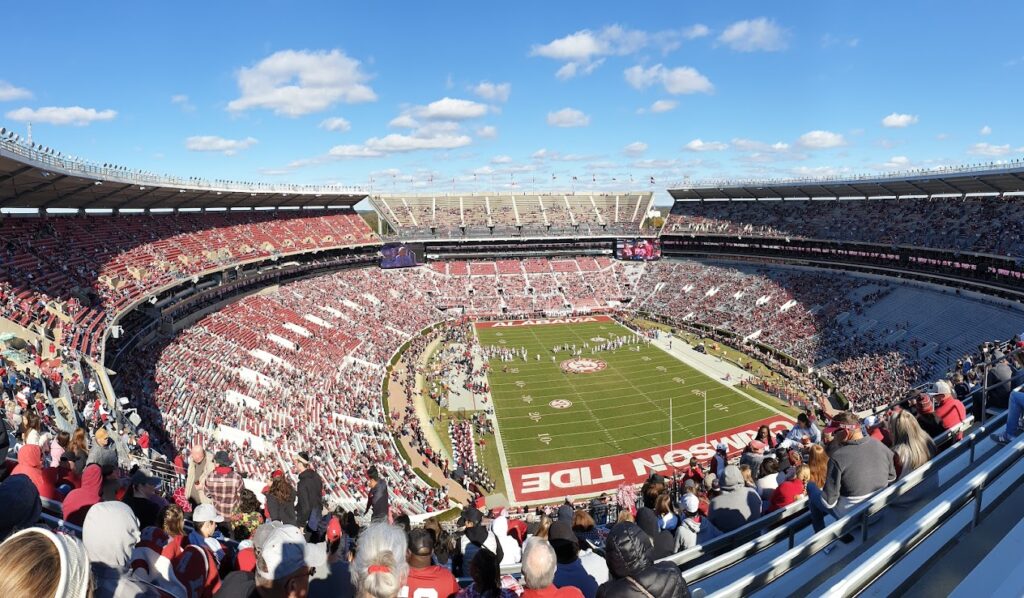A recycling company
As you probably know, our company specializes in e-recycling, and we applaud our customers who bring us their electronic devices and batteries for proper disposal. But recycling, in general, is vital if we want to preserve the health of our planet and, ultimately, ourselves.
There is no better example of recycling opportunities than the efforts put forth (or not) at college football stadiums that seat 90,000 to over 100,000 attendees. So, how do you recycle the trash caused by a full complement of rabid college football fans? Which mega-stadiums are stepping up to the challenges, and which ones need to catch up?
University of Michigan

Constructed in 1927, the football stadium at the University of Michigan, known as “The Big House,” boasts an official seating capacity of 107,601, although crowds of up to 115,000 were known to squeeze in. The university is conscious of the importance of recycling. If a sporting venue is to reach “zero waste,” it must achieve a Zero Waste status. Wolverine football fans see numerous signs in the stadium pointing the way to bins for recycling and composting. Food and beverage services use compostable cups, containers, and trays. After the game, cleanup crews sort the waste for distribution to the proper facility.
Penn State
The second largest Big Ten stadium is Penn State Beaver Stadium, with a capacity of 106,572. The university is enthusiastic about recycling. Home to the Nittany Lions, this stadium has almost 300 recycling carts scattered around its parking lot. Fans arriving at a game are given bags for their recyclables, with more bags available throughout the stadium. Stadium personnel also work with the Centre County Recycling and Refuse Authority to recycle waste.

The Ohio State University

Ohio Stadium has a capacity of 102,780 and maintains a Zero Waste designation: it diverts at least 90% of waste materials from landfills that will instead be recycled, composted, or repurposed. Ohio Stadium works with “I Am Change Outreach,” a nonprofit mentorship program for local high school and college students. During Buckeye football games, volunteers assist fans with waste disposal and spend at least 10 hours each game day to help the stadium work toward its Zero Waste objectives.
University of Tennessee

The Tennessee Vols play in front of 101,915 fans at Neyland Stadium.
This stadium strives toward Zero Waste goals. The university partners with the Eastman Chemical Company and is testing recycling initiatives at the stadium. For example, the partners collaborated on recycling plastic cups and bottles, using new technology to transform them into reusable water bottles. On game days, volunteers dubbed “waste warriors” collect recyclable materials and help fans dispose of waste properly.
University of Alabama

The state of Alabama has the reputation of having a less-than-stellar recycling rate. The University of Alabama’s Bryant-Denny Stadium has a meager 4.7% diversion rate for recyclables, which is perhaps unsurprising. In 2022, the university installed 150 new recycling containers, a step in the right direction. However, this was due to an expected increase in alcohol consumption among the 101,821 attendees the stadium could hold. It mainly addressed the presumed increase in aluminum can waste.
University of Georgia
The Georgia Bulldogs currently hold the title of National Champions in college football. However, the recycling efforts in Sanford Stadium need to meet championship standards—the diversion rate there is between 2% and 7%. The university encourages fans who fill up the 92,746 stadium seats to recycle. However, when the trash bins fill up during a game, people throw trash away in the adjacent recycling bins, contaminating the recyclables.
One fan, a Zero Waste Athletics Graduate Intern in UGA’s Office of Sustainability, had a solution. He obtained permission to test Zero Waste practices at Foley Field, the university’s 3,000-seat baseball stadium. He and his cohorts set up several bin stations around the stadium for sorting recyclables, compostables, and trash. Then, volunteers at each site answered questions from fans and helped them decide which waste materials to put into which bins.
The next step is to work out a Zero Waste program at Sanford Stadium, but we can overcome challenges. On the plus side, three of the primary sponsors of UGA athletics—Coca-Cola, Delta Airlines, and Georgia Power—are highly interested in sustainability initiatives and can help get the stadium’s Zero Waste program underway.
A trip to see a college football game is in your future. If so, have a great time! But remember the expectations for how fans should dispose of stadium trash and recyclables. In the meantime, remember to bring your used electronic devices to Ecycle Atlanta, and we’ll dispose of them correctly. Protecting our planet is a collective effort. Go team!
